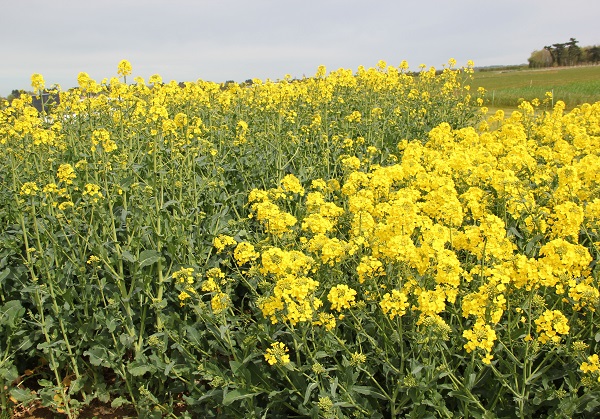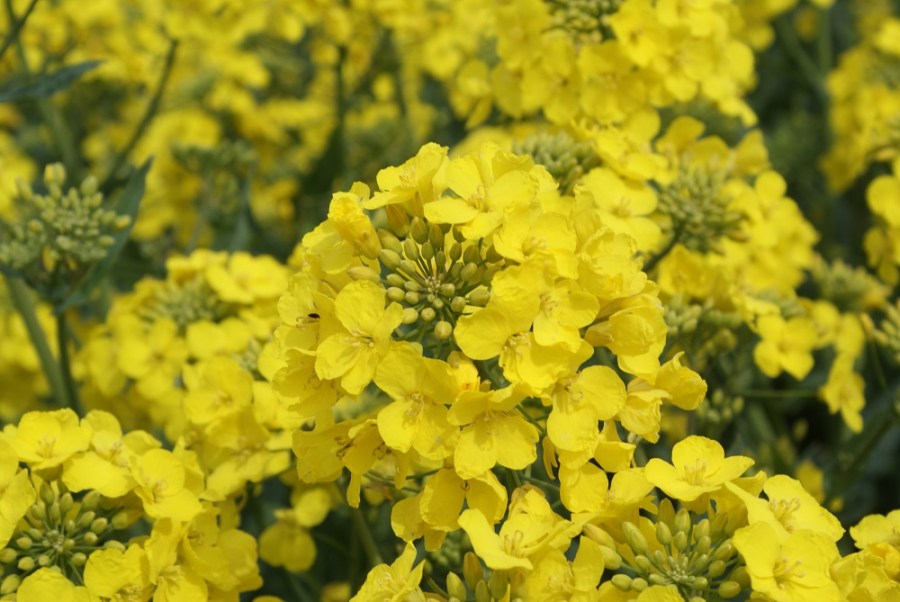Semi-dwarf OSR varieties can sometimes be the insurance option, but Dekalb’s latest offering, DK Secret, has the potential to be so much more.
It offers a lot more flexibility with fungicides and provides a generally easy package for growers.
By Melanie Jenkins
A low biomass hybrid, DK Secret combines high disease scores and standing ability with Dekalb’s signature pod shatter resistance, making it well suited to fertile ground.
This is a revolutionary semi-dwarf variety due to its combination of characteristics and low biomass, says Will Vaughan-France, technical specialist at Dekalb. “Previously, semi-dwarf varieties have been short and stiff but have often lacked yield, oil content and disease resistance. They’ve also been late to start autumn and spring growth and to flower. However, DK Secret is quite different to other semi-dwarf varieties; having extremely good disease scores, early flowering and early maturity.”

Poultry litter is incorporated in front of the OSR crop on Will Vaughan-France’s family farm in Somerset.
As a hybrid variety, DK Secret was bred with one female dwarf parent and one standard conventional male parent. The dwarf gene only has partial effect, as it’s neither recessive nor dominant, meaning the resultant variety is always halfway between a dwarf and a conventional, explains Matthew Clarke, breeder at Dekalb. “This makes it almost impossible to lodge and it forms a rosette in the winter which improves its winter hardiness, protecting it from bad weather.”
In AHDB Cereals and Oilseeds Recommended List trials, DK Secret yielded 100% of the control and produced an oil content of 44.5%. However, in Dekalb’s own 2016 strip trials near Perth in Scotland, it yielded 5.6t/ha and produced 46.5% oil, with a total gross output of 6.14t/ha.
The oil content of DK Secret is among the bottom performers on the RL, which surprised Simon Kightley at NAIB TAG. “I would expect an early maturing variety to have a higher oil content, so this is a slightly disappointing aspect to it. However, growers are often managing individual varieties to get the most out of them.”

DK Secret (on right) has the low biomass of semi-dwarf varieties but offers a step-up on disease scores, early flowering and early maturity.
As a low biomass variety, it has short straw, good stem stiffness and lodging resistance, making it easy to manage, explains David Bouch, seed manager at Hutchinsons. In terms of disease, DK Secret scored a 7 for light leaf spot and an 8 for phoma stem canker on the RL. “As far as we’re concerned, varieties need a minimum of 6 on disease,” he says. “On top of its disease scores, DK Secret has pod shatter resistance, meaning more seed into the barn and less volunteers. People are growing varieties on traits and consistency rather than on fluctuating gross output.”
What DK Secret really brings to growers is a combined disease score that’s as good, if not better, than anything else on the RL, says Simon Kightley.
Matthew Clarke agrees: “Alongside its semi-dwarf characteristics, DK Secret has good disease resistance, with double phoma resistance and very good LLS scores,” he says. “The double phoma resistance is a combination of the RLM7 gene and quantitative resistance, making it very durable.”
DK Secret is a short and extremely stiff variety, which offers a good straw package to growers, says Matt Phillips, director at GFP Agriculture. “It’s all about the whole package of the variety. The short straw coupled with good disease resistance, including the RLM7 gene, is very important.”
Having pod shatter resistance is an added benefit, says Matthew Clarke. “The upright growth habit of semi-dwarves can get blown around, so this protects the seeds better.” Pod shatter resistance is based on a complex of genes originally found in radish. These genes have been brought into the hybrid system to act as fertility restorers but they also alter the pod structure, which gives the resistance, he explains.
Characteristically, DK Secret offers growers the opportunity to plant before other hybrids as it won’t suffer from stem extension in mild winter weather, explains Matthew Clarke. It’ll also flower over a short period, making it easier to manage when it comes to sclerotinia spraying. “Traditionally, semi-dwarves are late flowering and maturing, but DK Secret is early for both, breaking the mould.”
Being quite early to get going and to flower, with a closed canopy, DK Secret will shut out late weeds more than other varieties, explains Simon Kightley.
In terms of management, Will Vaughan-France suggests applying fungicide for LLS later in the autumn season, with normal disease control in the spring. “Growers won’t need to do a great amount of growth regulation through stem extension, but it might be beneficial in the late yellow bud period to aid light penetration.” The flowering period can be quite short, so it may only need one sclerotinia spray, he adds.
Due to the pod shatter resistance and very early maturity, growers have more flexibility over timing of harvest. The low biomass of DK Secret will also make it easier to combine and leave less stubble, says Matt Phillips.
The variety is robust because of its disease resistance and semi-dwarf growth habit, so should be straightforward to grow, says Matthew Clarke. “It offers a lot more flexibility with fungicides and provides a generally easy package for growers.”
The normal rules for hybrids apply regarding seed rate with a benchmark of around 50 seeds/m², aiming for 30 plants, explains Will Vaughan-France. Fertiliser requirements will be similar to full height oilseed rape varieties, but growers should take care in spring when assessing the green area index, he adds. “Cutting and weighing is much more reliable than visual assessments because the flatter leaves of DK Secret can be misleading.”
Regionally there are slight differences to DK Secret’s gross output on the RL, but Will Vaughan-France says that it’s more important that the situation suits the variety. “If a farm has fertile soils, it doesn’t matter if this is in Devon or Aberdeenshire, the characteristics will be an advantage.” However, the variety is less suited to late drilling or particularly difficult growing conditions.
David Bouch argues that those growing lots of OSR should grow several varieties to spread the risk. “DK Secret will suit a multitude of growers; from those with a large acreage to others wishing to manage risk, or those wanting the security of a crop that’ll remain standing up. With less biomass going through the machine it’ll add efficiency and speed to harvesting which will be an important advantage.”
The main benefits that semi-dwarves offer haven’t been seen since the very bad lodging year of 2012, says Simon Kightley. “This is where the likes of Troy came out on top in the trial rankings, due to the loss of harvestability of taller varieties. In bad years, semi-dwarves are the only plots standing and lodging years are always waiting for us.”
DK Secret also offers advantages over other established semi-dwarf varieties, says Simon Kightley. “Growers on very fertile or exposed sites should take a real interest in it as it offers a higher yield than other semi-dwarves. However, it’s still a way off the standard top yielding varieties.”
How DK Secret will perform on the commercial market is likely to depend on the strength of merchant support this year, but David Bouch expects it to provide a sound package for Dekalb. “It might well appeal to growers who haven’t grown semi-dwarf varieties before, and it’s better to grow a consistent variety rather than one that changes year-to-year.”
DK Secret is an interesting step in a different direction from Dekalb, he adds. “They’re trying to redevelop low-biomass varieties and to evolve hybrids with similar traits. This is a potential opportunity for Dekalb if the gross output can be brought in line with the higher yielding varieties.”
Many growers will be looking to see more of DK Secret in trials later this year, says David Bouch. “It’s offering all the characteristics growers are after but the gross output may need to increase to make it more attractive. The proof of the pudding will be in its eating.”
Expecting results in Shrops farm trial
Dai Morgan, agronomist at BCW Agriculture, has been involved with a plot of DK Secret planted on his brother’s farm in Shrops. The 1ha plot was drilled on 29 Aug 2016 by Rob Morgan at Home Fam, Acton Burnell. Rob Morgan has grown other semi-dwarf varieties in the past and DK Secret appealed because of its good disease resistance and improved yield over other semi-dwarves.
The 110ha farm is situated on medium loams and has a four-year rotation consisting of wheat, second wheat, barley, and OSR, with OSR covering about 25ha. The DK Secret was drilled behind winter wheat using a power harrow combination drill following a sumo trio cultivation, at a rate of 30 seeds/m², with an application of biosolids at 20t/ha. The crop went into the ground in good conditions with the right moisture level and established well. “It’s in a field with another 10 varieties on trial and they all established equally well,” explains Dai Morgan.
The DK Secret had a pre-emergence herbicide followed up with a spray of graminicide and a fungicide in the autumn. “It had no trouble from flea beetle, slugs or pigeons and disease never got hold,” explains Dai Morgan. “The variety is doing fine in the field at the moment and there’s no rush for any spring inputs – it has been easy to look after.”
OSR is expected to yield around 4.85t/ha on the farm and DK Secret will need to equal the current varieties if Dai and Rob Morgan are to grow it again. The oil content would also need to hit the mid-40% mark.
“Despite its trial yield being lower than the taller varieties, it’s what ends up in the combine tank that’s most important, and with shorter crops, all of the yield ends up in the tank,” says Dai Morgan. “Not only do you get a higher yield, but less volunteer problems in following crops.”
Keeping it in the family
Will Vaughan-France grew a 2.5ha strip trial which included a 0.5ha plot of DK Secret on his family farm in Somerset in 2016. Cambria Farm, near Taunton, consists of 150ha of arable farmland as well as a poultry unit and is run by Will’s father, Paul Vaughan-France. The family grows wheat, winter barley, spring barley, beans and OSR, with OSR the main break crop.
The DK Secret was drilled behind spring barley on 7 Sept 2015 in a 9.3ha field, surrounded by DK Extrovert. Pre-drilling, 8t/ha of poultry litter was incorporated using a Simba DTX before the DK Secret was planted using a Väderstad Rapid at a rate of 40 seeds/m² in 25cm rows.
Fungicide applications were tailored to the surrounding DK Extrovert and included Tubosan in the autumn and at early stem extension, with Toprex at yellow bud and Pictor mid-flowering.
Due to the application of the poultry muck, the canopy was fairly strong and the green area index was very high in early spring. After winter, around 165kgN/ha was applied across the whole field, split as: 48kgN/ha of liquid N30 in early March, 21kgN/ha of ammonium sulphate in mid-March and 96kgN/ha of liquid N30 in early April.
The DK Secret was desiccated with Roundup PowerMax (glyphosate) and harvested on 31 July 2016, yielding 3.83t/ha with a gross output of 3.91t/ha. Will Vaughan-France found combining DK Secret interesting as the combine was able to travel at around 5-5.5km/h, compared with 3-4km/h while combining DK Extrovert and DK Exception – both taller varieties. “We were able to harvest at least an extra 0.6ha/hr,” he says.
“To all intents and purposes the DK Secret performed as well as the DK Extrovert which performs consistently well on our farm. We would grow it again as it suits the farm’s fertile land and lodging can be a significant risk to us.”
DK Secret at a glance





